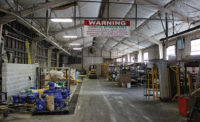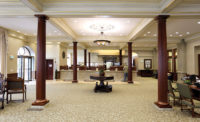
Question: Lately we have seen a lot of stone flooring patterns that combine marble and granite together. How do we refinish these materials together? What diamonds do we use and what is the procedure?
Answer: You are correct. There are a lot of combination floors out there. Not only are they using marble and granite together, but I am also seeing marble, wood, metal and other materials used in the same floor. This makes it a real challenge to refinish. There are ways to refinish them, and the following procedure should help with these combination floors.
Marble/Granite Combination refinishing procedure
In cases where both the marble and granite are worn and need refinishing, the following procedure should be used. This procedure primarily ignores the marble and concentrates on the granite -- making the assumption that the marble will reach a polish before the granite. It is advised that granite diamond abrasives be used for this procedure. Check with the diamond manufacturer to be sure diamonds are suitable for both marble and granite.This procedure requires complete lippage removal, regardless of the lippage thickness.
The following procedure uses a standard 17- to 20-inch, 175- to 300-rpm floor buffing machine. However, we highly recommend the use of heavier machines designed to perform granite work. The newer planetary head machines are excellent for this type of work. If using the standard machine, add as much weight as the machine can safely handle.
Step 1. Remove all furniture from the floor surface. Be careful not to slide heavy pieces across the floor, since this can cause irreversible damage.
Step 2. Protect all wall surfaces and baseboards by covering with plastic or paper sheeting. Tape plastic/paper to wall surface using only low-contact masking tape. Protect walls to a height of at least 24 inches measured from the floor up. If dealing with a sensitive wall surface such as silk wallpaper or decorative painting, test the tape to make sure it does not damage these surfaces. Adjacent carpeting should be pulled back or covered. Wood flooring and other water sensitive material should also be covered.
Step 3. Dust mop the entire floor to remove loose debris. Scrape any large chunks of grout or thin-set and remove any tape, gum, etc.
Step 4. If the floor has a heavy application of waxes or other coatings, these will need to be removed before refinishing. Use a stripper designed to remove the coating and following manufacturers directions for procedures.
Step 5. Place a total of three to six 60-grit diamond discs or lippage tools on the pad driver of your floor machine. (Note: There are dozens of diamond manufacturers and abrasive types. These procedures use the most common diamond disc sizes. The number of discs and grit sizes required may differ from manufacturer to manufacturer. Refer to the manufacturers directions for details. Manufacturer may also recommend a lower starting grit. Lippage plates designed to remove heavy lippage may also be used.)
Add water to the floor and begin grinding. Move the machine in a back-and-forth motion slowly across the floor. Do not grind all the way to the wall. Stay at least 12 inches from the wall (see note below). Keep the machine moving, working in 4- x 4-foot sections. Continue to add enough water so the diamond discs do not become clogged with marble slurry. (Note: Blending and/or feathering into the edges will only work if the edges are marble. If granite is near the edge, all the edges will have to be done by hand.)
Take a window squeegee and swipe the surface of the stone to check your work. Make sure the tiles are completely flat. Run your finger across the grout line. Another effective way to check for lippage is to take a nickel and place it next to the grout line. Carefully and slowly slide the nickel across the grout. If it runs smoothly, the lippage is gone.
Continue to grind the floor in small 4- x 4-foot sections until the entire floor is flat. (Note: Be sure to stay away from the wall and baseboards. Keep at least 12 inches away unless edge work is to be done by hand.)
Step 6. Once all the lippage is eliminated, vacuum all slurry from the floor and rinse several times with clean water. Allow the floor to dry several minutes and examine the surface of the marble/granite carefully. Do you have a consistent scratch pattern? Are all tiles flat? The appearance of shiny edges along the grout line indicate lippage is still present.
Step 7. Remove the 60-grit diamond discs and place the next grit size (120) on the drive plate. Run this grit size across the floor as you did with the 60-grit, continue to work in 4- x 4-foot sections and add water as needed. Overlap this grit an additional 2 inches where you stopped with the 60-grit unless performing edge work by hand. (Note: If not working edges by hand, overlapping successive grits is important. If grits are not carefully overlapped, a dull "halo" will appear along the baseboards.)
Continue to work this grit until you obtain a consistent scratch pattern. If necessary, vacuum the entire floor, allow it to dry and examine to make sure all previous scratches are removed. Rinse the floor before proceeding to the next grit.
Step 8. Remove the diamond discs and attach the next grit size. Work these the same way you did the previous grit, making sure you remove all scratches created by the previous grit. Overlap this grit an additional 2 inches except where noted. Repeat Steps 7 and 8 with any successive grits recommended by the diamond abrasive manufacturer. Rinse and allow the floor to dry and examine carefully.
Step 9. Once the floor has a consistent honed appearance, it is now ready for polishing. If the floor is to be left in a honed finish, stop here. Place a polishing pad, lead felt or felt pad under the floor machine. Polish all the granite first using the granite polishing procedure. Refer to instructions of polishing powder for pad recommendations.
If necessary, polish the marble as follows: Place a white or tan polishing pad under the floor machine. Add approximately 1 teaspoon of marble polishing powder under the polishing pad. Add a little water and begin working the machine in a slow back-and-forth motion. Add only enough water so that the circular pattern left by the slurry is visible. Do not allow the powder to dry on the floor. Do not worry about polishing over the granite. Most marble polishing powders will not harm granite.
As in the honing stage, work in small 4- x 4-foot sections.
Step 10. Continue to work and pull the slurry back and examine the area. When the desired shine is obtained, pick up the slurry with a wet vacuum and immediately apply clean water to the area. Pick up the water and reapply additional water.
Before moving to the next 4- x 4-foot section, apply a thin layer of clean water to the section you just completed. Keep this section wet, and you will not etch the newly completed section with the splash from the floor machine.
Continue polishing in this manner until the entire floor is complete.
Step 11. Once the floor is entirely polished, rinse the entire floor again. Place a clean white pad on your floor machine and buff any remaining film or residue.
Wait at least 24 hours before applying any penetrating sealers
Another technique for refinishing combinations where the marble is worn, but the granite does not need any work, is to tape the granite with duct tape. Most of the resin-bond diamonds will ride up over the duct tape, allowing you to hone only the marble. When it is time to polish, simply remove the duct tape and polish the entire floor -- granite and marble -- with a marble polishing powder. The powder should not do anything to the granite.

